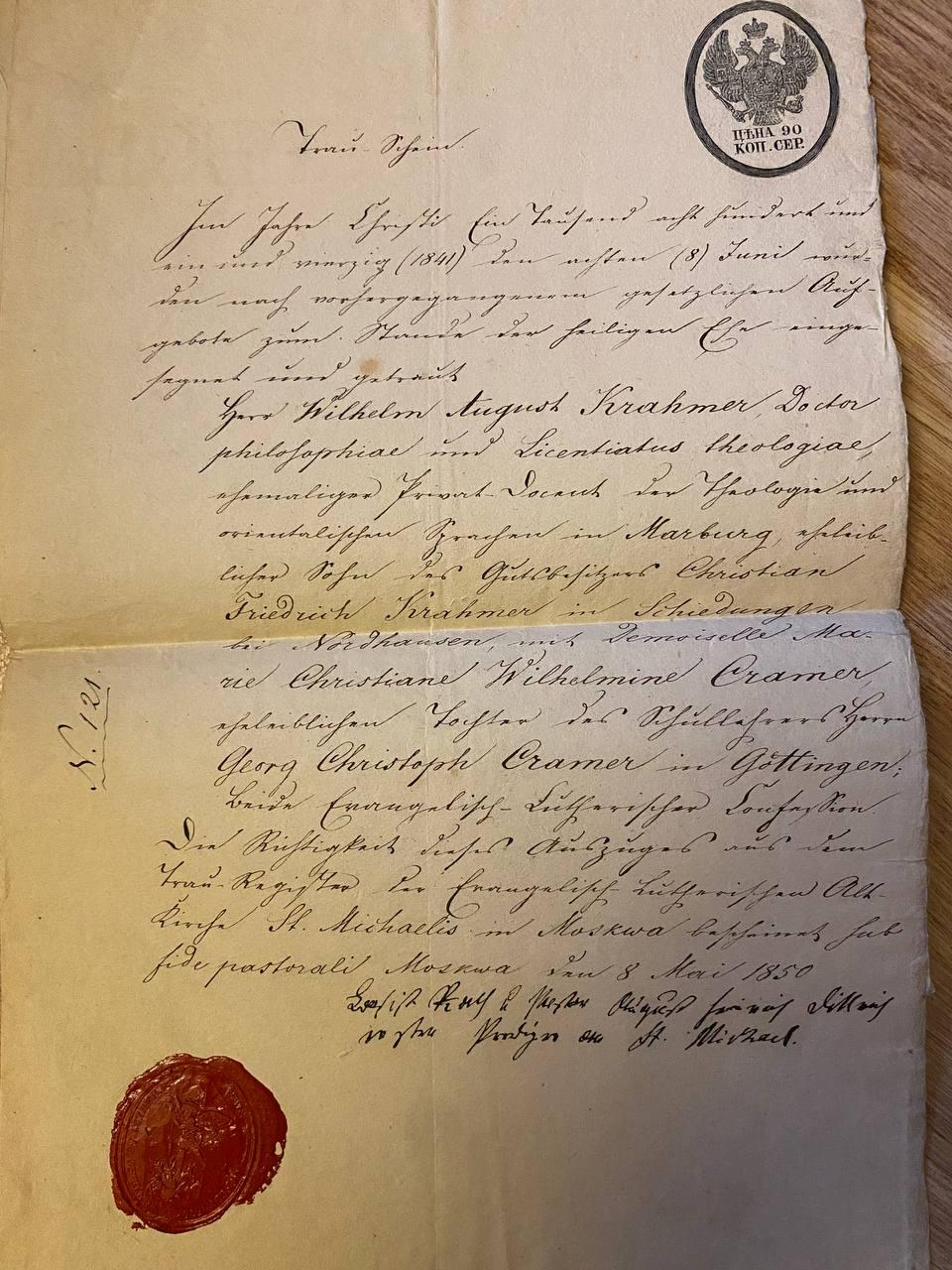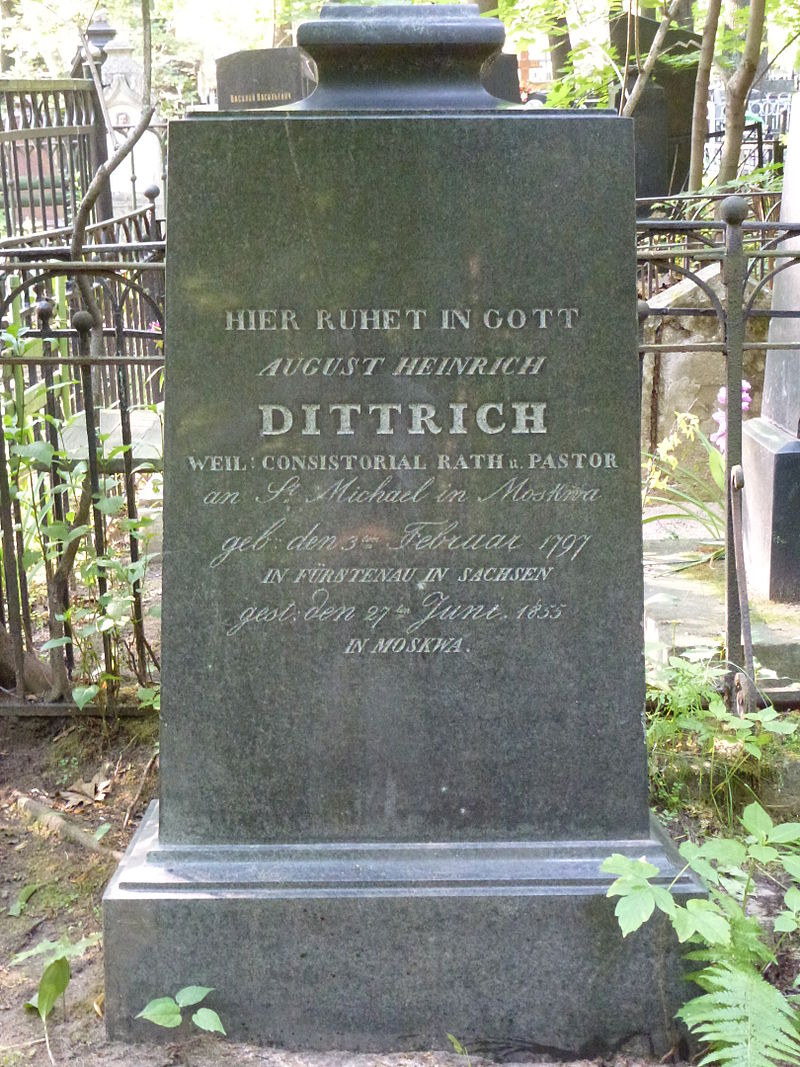I have some documents written in German. I can barely make out some of the words. May be someone could read or understand what kind of document this is?
-
4german.meta.stackexchange.com/q/1656, german.meta.stackexchange.com/q/579, german.meta.stackexchange.com/q/1275. Can you include what kind of insights you already have, what you understood? The community tends to appreciate the own efforts by the askers. That said, welcome to German SE and I am also curious about what the answers will be. In the meantime, the tour and the help center will get you started on how the site ams the SE system works.– StephieCommented Dec 20, 2022 at 9:16
2 Answers
You already know that the document is a marriage certificate. Here is a transcription of the handwritten text.
Trau-Schein.
Im Jahre Christi Ein Tausend acht hundert und
ein und vierzig (1841) den achten (8) Juni wur=
den nach vorhergegangenem gesetzlichen Auf-
gebote zum Stande der heiligen Ehe einge-
segnet und getraut
Herr Wilhelm August Krahmer, Doctor
philosophiae und Licentiatus theologiae,
ehemaliger Privat-Docent der Theologie und
orientalischen Sprachen in Marburg, eheleib-
licher Sohn des Gutsbesitzers Christian
Friedrich Krahmer in Schiedungen
bei Nordhausen, mit Demoiselle Ma-
rie Christiane Wilhelmine Cramer,
eheleiblichen Tochter des Schullehrers Herrn
Georg Christoph Cramer in Göttingen;
beide Evangelisch-Lutherischer Confession.
Die Richtigkeit dieses Auszuges aus dem
Trau-Register der Evangelisch-Lutherischen Alt-
Kirche St. Michealis in Moskwa bescheinet(?) sub
fide pastorali Moskwa den 8. Mai 1850
The last two lines are very difficult to read. Certainly they have been written by the pastor of St. Michael to confirm the correctness of the excerpt.
Consist(?) Rath(?) u Pastor August Heinrich Dittrich
erster Prediger an St. Michael
Comments:
Both = and - are used as separators for word division at line breaks.
St. Michael in Moscow was one of the oldest evangelic-Lutheran churches in Russia. It was founded 1576. See https://enc.rusdeutsch.eu/articles/5930. Here is some more detail about that church.
The word "bescheinet" was marked with a (?) because I am not sure whether it is correct. In my opinion "bescheinigt" would be the appropriate expression, but the handwritten word does not contain the letter "g".
The phrase "eheleibliches Kind" is no longer in use in contemporary German. It combines "eheliches Kind" (legitimate child) and "leibliches Kind" (natural child).
Concerning the place Schiedungen see https://de.wikipedia.org/wiki/Schiedungen. For Wilhelm August Krahmer see https://www.ancestry.com/genealogy/records/august-wilhelm-krahmer-24-1kz5zph.
The handwriting is a mixture of Kurrent and Latin cursive. Names of persons and places as well as Latin phrases (e.g. Doctor philosophiae) and dates (Juni, Mai) are written in Latin cursive.
The Latin phrase "sub fide pastorali" means this document was certified by a priest.
The "u" in the second last line stands for "und".
Dittrich's gravestone in Moscow suggests that the first two words in the in the second last line are Consist (abbreviation for "Consistorial") and Rath:
-
1Eine Kleinigkeit: Z. 8 lies "Licentiatus theologiae" statt "theologicae" Commented Apr 25, 2023 at 8:27
-
@marquinho Danke für den Hinweis! Ich habe das berichtigt. Commented Apr 25, 2023 at 21:43
-
2@Arsak Danke für die Transkription der beiden letzten Zeilen. Ich habe zumindest den Namen finden können. Commented Sep 14, 2023 at 0:20
-
2Excellent source work there - the gravestone! Please accept my imaginary second upvote. Commented Sep 14, 2023 at 10:41
-
1
It apparently is a marriage certificate ("Trauschein") between Wilhelm August Krahmer and Marie Christiane Wilhelmine Cramer, married 8. Jun 1841 in Moscow.
The document is an excerpt from the marriage register of the evangelic-lutheric church St Michaelis in Moscow ("Moskwa") which was created 9 years later.
It goes on to mention that Wilhelm was a Doctor of Philosophy and "licensed theologist" (whatever that was) and the son of an estate farm owner Christian Friedrich Krahmer in Nordhausen.
Marie's Father Georg was a teacher from Göttingen.
-
-
4Licentiate is (in a German context) an outdated academic degree, that especially gave permission to teach theology.– ccprogCommented Dec 20, 2022 at 10:51
-
@АняКрамер See german.stackexchange.com/help/someone-answers Commented Dec 23, 2022 at 16:32


